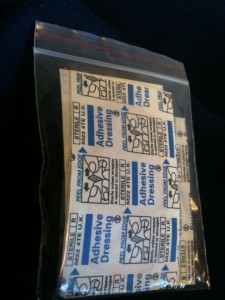A couple of weeks ago myself, Jon and Tom attended a first aid course for outdoor professionals to refresh ourselves on those vital skills. I thought I’d take this opportunity to discuss what I choose to have in my first aid kit on the river, and why. What you choose to take with you is a personal decision, but one worth considering.
What do I put it in?
I use a Lifesystems Compact First Aid kit pack. I find it a good size and fairly water resistant.

I put this inside a 10 litre drybag with a few extra things (I will come on to them later). I have clearly marked the dry bag as FIRST AID, so other people can quickly identify it in an emergency. You may want to purchase a sticker to put on your dry bag / peli case.
Inside the red pack…
If you open the pack shown above, you will immediately see 2 pairs of non-latex gloves. When an incident has taken place it is all too easy to rush in to try and help. Make sure you protect yourself and others from cross-contamination – WEAR GLOVES. Putting them here means you cannot forget!
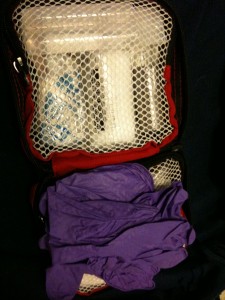
So what else?
- A range of hypo-allergenic plasters
- Some stretchy sticky fabric tape (hypo-allergenic)
- Micro-pore tape
- 3 sizes of sterile dressings / bandages
- A range of sizes of adhesive dressings
- 2 tubes of sterile water
- Face mask
- 6 alcohol free antiseptic wipes
- Triangular bandage
- Ducktape
- Scissors
I keep everything in little sealable plastic bags, just to give extra protection against getting wet:
I keep the ducktape on a bit of old broken pen. This allows me to store a good amount in a compact yet easy to dispense format.
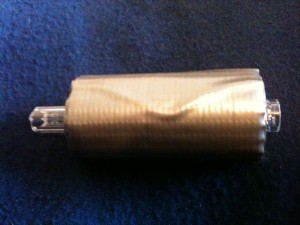
Also in the dry bag…
I carry some waterproof paper, with a small IKEA pencil tucked in the coils so I can note down any details such as the casualty’s name, what happened, what treatment has been given, vital stats etc. Along with this I carry a little prompt card, cos even the most well trained can find themselves forgetting everything at the sight of a loved one in dire medical trouble. You can use these to record on, but I find that in our environment a waterproof pad is much easier. Pencils can withstand being wet, pens to write on laminated card don’t tend to like it.
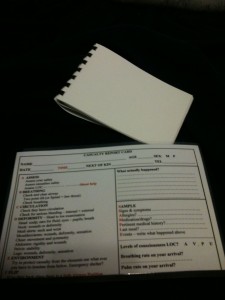
Savlon spray is a great antiseptic that also handily dries wounds – very handy in wet environments. And Compeed is fab for blisters / rubbing – the Savlon spray can be used first to dry out the area. these are not essentials, but pretty useful I think.
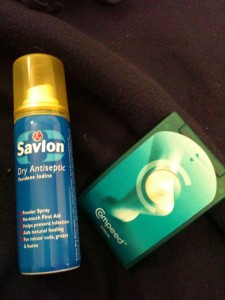
I also carry a “Blizzard Vest”, which is a like a big corrugated, hooded foil jumper that you can stick over anyone getting cold. It’s vacuum packed, and if you have to use it you can send it back to be re-packed!
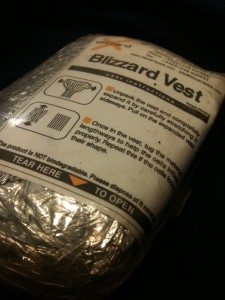
If someone is injured they get cold really fast, especially outdoors. However, don’t forget that the rest of the group might be getting cold too. This is why I have another dry bag…
The other drybag…
I carry a separate dry bag for what I would call “group kit”. In there I have a group shelter, some emergency foods and spare clothing. The reason I have this separate is because there are some places I don’t feel it is necessary to carry these things, like at managed sites such as Canolfan Tryweryn. At these sites I would still usually carry a first aid kit though, just in case.
The call for help…
 I cannot recommend strongly enough that every group take a mobile phone with them on the water. Put it in an aquapac and carry it on your person.
I cannot recommend strongly enough that every group take a mobile phone with them on the water. Put it in an aquapac and carry it on your person.
Yes, there isn’t always signal in the remote and mountainous regions we go to, but it’s usually nearer than the nearest payphone or house. And those things will be there whether or not you are carrying a phone – so why not? If you don’t want to be disturbed, just turn it off. If you are worried about damaging your expensive smart phone, buy a £10 handset and put a pay-as-you-go sim in it – just make sure to check the battery before you leave!
Conclusion
White water kayaking is an adventure sport – one which involves an element of risk and many risks of the elements. Hopefully anyone who goes paddling regularly can see that if something were to go wrong, you are likely to be a little way from help. In my opinion, all paddlers should attend a good first aid course at least once every 3 years. Rescue Emergency Care courses are good because they are not restrained by HSE First Aid at Work and are designed for people who will be operating in the outdoor environment. There is quite a difference between the potential seriousness of a broken leg in an office carpark and one beside a steep-banked river in Scotland in the middle of winter, for instance.
I hope you never need to use first aid; but if you do I hope you are equipped and trained appropriately. I’m sure your friends and family would hope the same.


